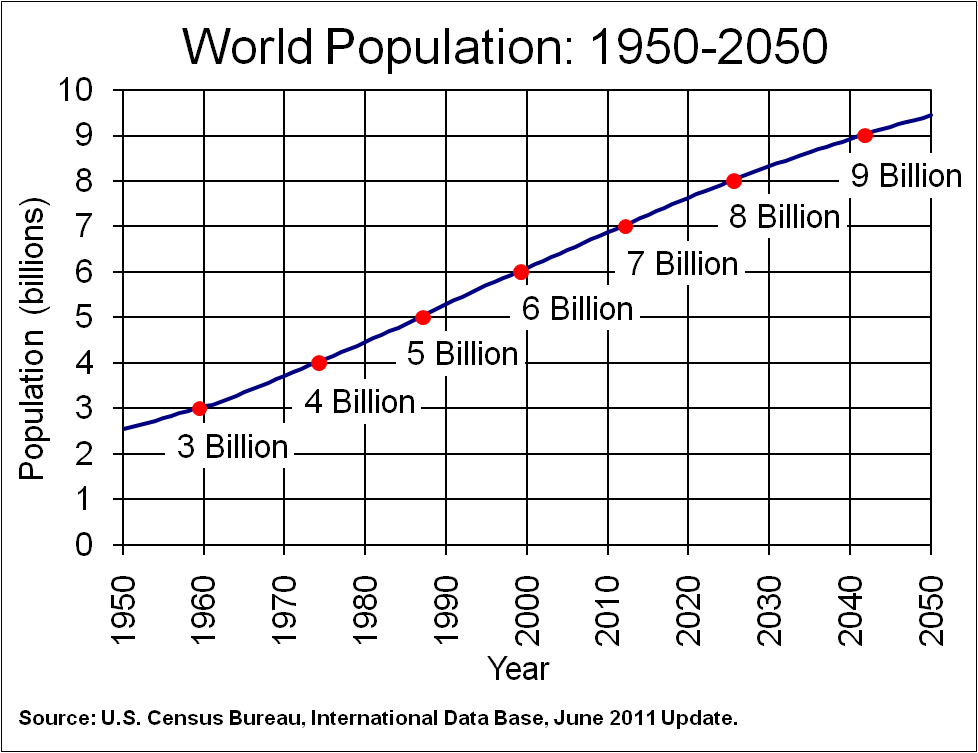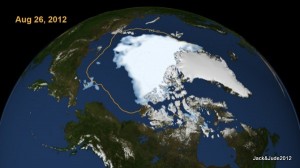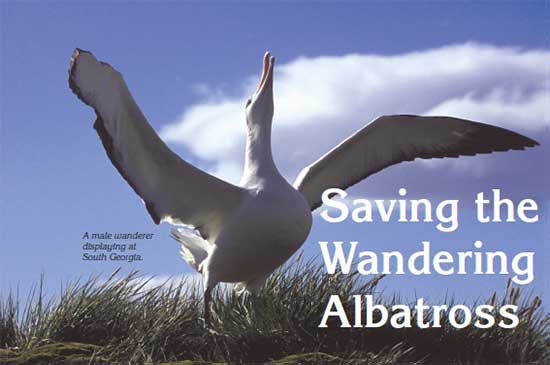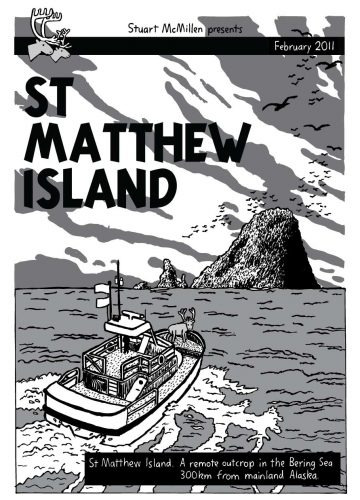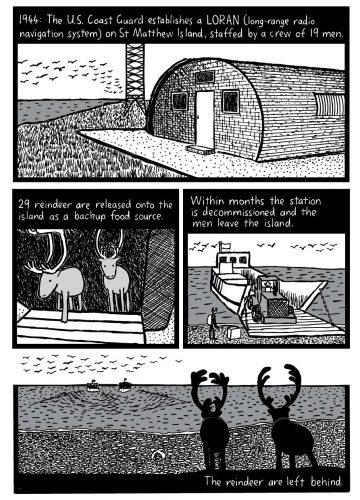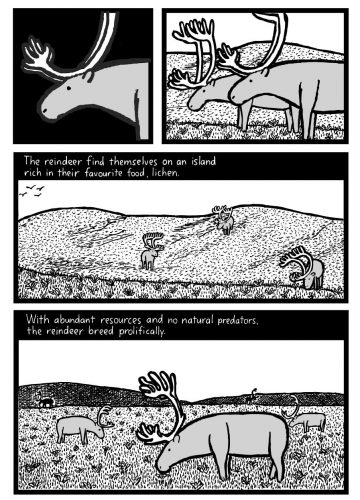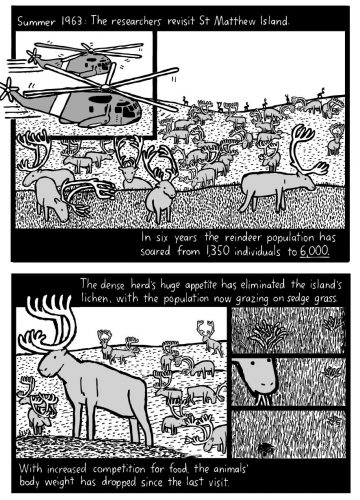On this Page:
- Abbot Point Coal Port Approval – 15 Dec 2013
- China Chips Away at One-Child Policy – 19 Nov 2013
- First Detailed Map of Global Forest Change – 14 Nov 2013
- Disaster Strikes Earth – Investors Cheer – 24 Oct 2013
- Where has all the Seagrass gone? – 19 Oct 2013
- Join the world’s biggest plankton survey – 23 Feb 2013
- A brutal week in climate politics – 19 Sept 2013
- Once Decimated U.S. Fish Stocks Enjoy Big Bounce Back – 26 Mar 2013
- Global warming shrinks size of marine species – 6 Nov 2012
- Your Children will soon inherit the climate problem – 29 Oct 2012
- Barrier reef half-dead under Australia’s Watch – 3 Oct 2012
- Saving the Wandering Albatross – 29 Sep 2012
- The world’s extinct and endangered species – 11 Sep 2012
- Ocean Acidification – 14 Jun 2012
- The Tasman Sea: Australia’s ocean hotspot – 1 Feb 2012
- The Global Population Situation – 1 Jan 2012
- St. Matthew Island – A cute comic if it wasn’t happening to us
Abbot Point Coal Port Approval –
A Death Sentence for Great Barrier Reef
15 Dec 2013 – Abbot Point coal port approval signals the Coalition government’s industrialization of one of the most beautiful and fragile ecosystems on Earth. A combination of four terminals will ship an additional 190 million tonnes of coal every year for decades to come. It means continuously loading coal onto 1500 ships inside the Great Barrier Reef every year. Environment Minister Greg Hunt has given the project approval to dump 3 million tonnes of dredging waste in the ocean. That’s equivalent to 150,000 dump trucks, lined up bumper to bumper from Brisbane to Melbourne, tipping waste into the ocean.
“Mining activities presented a greater threat to the reef than agriculture,”
says Research scientist Jon Brodie from the James Cook University.
”Farmers are going to be asked to save the reef when port authorities and climate change managers are doing nothing,” he said. ”It puts it all back on farmers.” Agricultural activity within the Great Barrier Reef catchment area, such as beef grazing and farming releases sediment, chemical and fertiliser run-off. This is discharged from rivers into the sea. However, Mr Brodie said the damage from the expansion of ports, including dredging sediments contaminated with heavy metals, could prove a greater threat to the health of the reef because – unlike run-off from agriculture – port development was occurring without any transparent and productive management of the risks. The area off Abbot Point, where 3-million cubic metres of seabed will be dredged and dumped as part of the expansion, is near marine habitats, such as coral reefs and seagrass meadows that provide shelter and food for fish, turtles and dugongs. Cloudy water reduces the reach of sunlight that corals and seagrasses need for growth.
More Coal Ports Proposed
Coal export terminals are proposed from Gladstone to Cape York. In addition to Abbot Point, expansion of an existing coal terminals is under way at Hay Point and Brisbane Coal Terminal while new coal terminals are proposed at Cape York, Wiggins Island and Balaclava Island. Total coal tonnage is proposed to increase more than six-fold by the end of this decade.
“The Abbott Government has sacrificed the climate and the Great Barrier Reef for overseas mining companies with its approval today of the world’s largest coal port and another CSG plant in our Great Barrier Reef,” said Queensland Greens Senator Larissa Waters.
[Return to Contents]
UPDATE 03 FEBRUARY
Great Barrier Reef to Become Sludge Repository
SYDNEY, AUSTRALIA—The Australian agency tasked with managing the Great Barrier Reef has authorized what amounts to an experiment opposed by many scientists: how the iconic ecosystem will respond to mountains of sludge dumped into the waters between the reef and the Australian mainland. On Friday, the federal Marine Park Authority paved the way for development of one of the world’s largest coal ports by approving the dumping of up to 3 million cubic meters of dredge spoils inside the UNESCO World Heritage Site.
[Return to Contents]
China Chips Away at One-Child Policy
Greater demand for energy, resources, more pollution predicted.
BEIJING 19 Nov 2013 – China’s relaxation of its one-child policy, announced last week, is unlikely to spark a baby boom. But it may be a steppingstone to a bigger change that influences when the nation’s population peaks—a milestone with major ramifications for food security. Writes Yadan Ouyang of The Economist from Beijing. The government announced on 15 November that it will allow Chinese couples to have two children if one spouse is an only child. Exceptions to the one-child rule already exist for ethnic minorities, rural families without boys, and couples in which both parents are only children. But Chinese demographers have long called for wider changes, arguing that the decades-old policy has contributed to a series of social problems, such as the country’s aging population, gender imbalance, and labor shortages. Official statistics show that China’s fertility rate has dropped from 2.86 in 1982 to about 1.5 to 1.6 births per woman now. The new policy could affect millions of lives, but demographers and policymakers believe it won’t have a significant impact on China’s current demographic reality. The policy will allow up to 12 million women of reproductive age in China to have a second child, according to estimates by Wang Guangzhou, a demographer at the Chinese Academy of Social Sciences. In a study published in the Chinese journal Sociological Studies in September 2012, Wang and his colleagues estimate that the new policy, if carried out nationwide in 2015, could lead to 1 million to 2 million additional births a year, on top of the 15 million births a year at present. The team also forecast that under the change, China’s total population would peak at 1.4 billion by 2029 and decline to 1.3 billion by 2050.
[Return to Contents]
First Detailed Map of Global Forest Change
Between 2000 and 2012
A Global LOSS of 2.3 million square kilometers of established forest (888,000 sq. miles)
Vs
A GAIN of 800,000 square kilometers of new forest (309,000 sq. miles) .
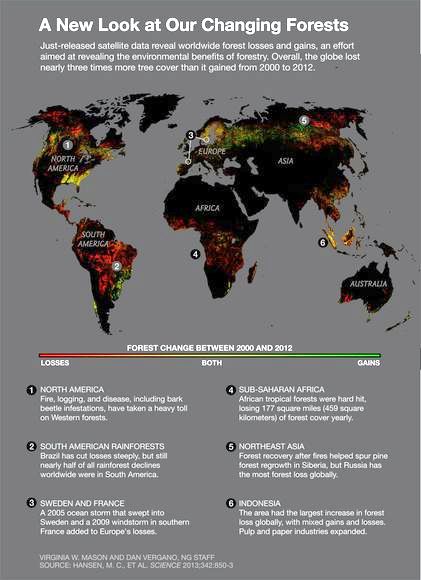 Nov. 14, 2013 — A University of Maryland-led, multi-organizational team has created the first high-resolution global map of forest extent, loss and gain. This resource greatly improves the ability to understand human and naturally-induced forest changes and the local to global implications of these changes on environmental, economic and other natural and societal systems, members of the team say.
Nov. 14, 2013 — A University of Maryland-led, multi-organizational team has created the first high-resolution global map of forest extent, loss and gain. This resource greatly improves the ability to understand human and naturally-induced forest changes and the local to global implications of these changes on environmental, economic and other natural and societal systems, members of the team say.
In a new study, the team of 15 university, Google and government researchers reports a global loss of 2.3 million square kilometers (888,000 square miles) of forest between 2000 and 2012 and a gain of 800,000 square kilometers (309,000 square miles) of new forest. Their study, published online on November 14 in the journal Science, documents the new database, including a number of key findings on global forest change. For example, the tropics were the only climate domain to exhibit a trend, with forest loss increasing by 2,101 square kilometers (811 square miles) per year. Brazil’s well-documented reduction in deforestation during the last decade was more than offset by increasing forest loss in Indonesia, Malaysia, Paraguay, Bolivia, Zambia, Angola and elsewhere.
[Return to Contents]
Disaster Strikes Earth – Investors Cheer
October 24, 2013 The Financial Times Ltd – BHP Billiton has forecast growth over the next 15 years of up to 75 per cent in demand for some commodities – especially energy. This article does not disclose that this huge increase in demand is due to the mass movement of Chinese peasants from rural lands into the cities, seeing a huge demand for new housing, automobiles, electronics.
This of course has heartened investors. BUT the reality is that Earth is already under great stress for energy, timber, water, and food, and that this will only increase as underdeveloped populations demand the same quality of life experienced in the more developed parts of Earth. What is the Answer? Reducing world population! How? By educating the masses and changing the management system away from consumerism.
Death by a Thousand Cuts –
SHARK BAY – Where has all the Seagrass gone?
Oct. 19, 2013 – Tourists prize Shark Bay for the dolphins of Monkey Mia and Hamelin Pool’s bizarre ‘living fossils,’ the stromatolites, which are living colonies of primitive blue green algae established around 3500 million years ago.
However, for marine biologists and environmentalists, Shark Bay is also home to the world’s largest seagrass bank. The Wooramel seagrass bank – named for the Wooramel River, which feeds nutrient-laden sediment into the bay – stretches for 1030 sq km. This vast underwater meadow includes 12 species of seagrass – more species than any seagrass ecosystem in the world.
This habitat provides food and shelter to a diversity of marine life, from invertebrates and fish, to foraging dugongs and sea turtles. So you can gauge how important it is to Earth and her creatures But how might this World-Heritage listed ecosystem fare in a changing world? Nature is already providing some clues.
In December 2010, the area experienced its biggest flood event on record, with over 200 mm of rain in a single day recorded in the nearby town of Carnarvon. During the floods, the Wooramel River dumped large volumes of freshwater and sediment onto the seagrass beds. Soon after, in February 2011, scientists noticed that seawater temperatures in the seagrass bank were among the highest recorded in the region, with mean temperatures of around 29°C. In fact, an extreme ocean heatwave at the time resulted in temperatures that were 2–4°C above the long-term averages for that part of the WA coastline during late summer. The occurrence of the two extreme weather events – flooding and ocean warming – within the space of months gave researchers an opportunity to see how predicted changes in climate under global warming might impact on Shark Bay’s seagrass ecosystems.
Researchers already knew that turbidity and light reduction is a major driver of seagrass loss worldwide, as suspended sediment blocks out the sunlight required for photosynthesis. At Shark Bay, the prevailing winds swept the Wooramel River’s flood plume many kilometres north of the mouth of delta at the time of the 2011 flood event, contributing to visible seagrass dieoff up to 15 km away from the river’s mouth. In 2011, a WA research team observed widespread defoliation of the temperate seagrass Amphibolis antarctica – the most widespread canopy-forming seagrass in Shark Bay. They proposed that, while this defoliation was primarily correlated with distance from the Wooramel River delta – a measure of the flood plume extent – the combined effects of higher turbidity and temperatures resulted in greater defoliation than either effect alone.
Earlier laboratory experiments had already shown that fewer A. antarctica seedlings survive in seawater temperatures above 25°C, with significant decline occurring above 30°C. Temperature thresholds for the tropical seagrass Halodule uninervis, however, are higher – above 30°C. This would explain why A. antarctica fared worse in the heatwave than H. uninervis – in fact, the WA study concludes that in warming seas, tropical species like H. uninervis may replace temperate ones as the dominant seagrasses in Shark Bay.

A dying stand of A. antarctica, showing turbidity and residue from the 2010-11 flood plumes. Credit: M. Vanderklift
Hamelin Pool
The scientists also warn that predicted sea level increases of around 7 cm under climate change might lead to a salinity drop in the hypersaline Hamelin Pool, with results that are difficult to predict. Interestingly, the rise in sea level may also reduce light levels in the existing seagrass meadow, impacting productivity. Why does all this matter? Seagrass meadows provide critical ecosystem services in the form of nutrient recycling, and food or habitat for marine mammals, fishes, birds, turtles and invertebrates. Globally, seagrass loss rates are comparable with those reported for mangroves, coral reefs, and tropical rainforests, placing seagrass meadows among the most threatened ecosystems on earth. Source: The Argo program measures the temperature and salinity of ocean surface waters around the world. It deploys floats that measure salinity and temperature throughout the surface layer of the ocean. Over 3,000 free-drifting floats have been deployed all over the ocean and each float is programmed to sink 2,000 metres down, drifting at that depth for about 10 days. Floats make their way to the surface measuring temperature and salinity the whole time. Data is transmitted to a satellite once the float reaches the surface, so that scientists and the public have access to information about the state of the ocean within hours of the data collection. The Remote Sensing Group in CSIRO’s Marine and Atmospheric Research Division (CMAR) publish Argo data collected via satellite remote sensing.
- Please visit “OceanCurrent – Ocean Surface Currents and Temperature”: http://www.marine.csiro.au/
remotesensing/oceancurrents/ - Further information about the CMAR Remote Sensing services is available at: http://www.cmar.csiro.au/
remotesensing/
Sailors turned Scientists:
Join the world’s biggest plankton survey
23 Feb 2013 – A recent study has suggested that the phytoplankton in the oceans that underpin the whole marine food chain has declined by 40% since the 1950s due to climate change. A team of scientists from Plymouth University, UK, have created a mobile phone app called Secchi and a Citizen Science project to encourage thousands of seafarers around the world to take part in a global study of plankton. The Canadian scientist’s study provoked debate among many marine biologists however, as some thought they saw different results. Part of the controversy arises from the fact that the oceans are a vast place and there aren’t enough marine biologists to study them. This is where you, the sailor, can help – by becoming a Citizen Scientist. CLICK For more information. What does being a Citizen Scientist involve?
[Return to Contents]
A brutal week in climate politics
Sep. 19, 2013 – What an inglorious week in the short history of Australian action to tackle climate change. In a brutal 48 hours the new federal government abolished the Climate Commission, which had been set up to give information to the public about the global warming problem and potential solutions, and started a process designed to close down the Climate Change Authority, the body that gives advice to government on emission reduction targets. New Environment Minister Greg Hunt scrapped the Australian Climate Commission in one of his first acts as minister last week, and said overnight that Dr Flannery’s plans to establish a ‘Climate Council’ vindicated his decision. ‘It proves our point that the commission didn’t have to be a taxpayer funded body,’ the minister said. We think NOT and ask you to support the Cilmate Council, as we have, to ensure we get correct information on the changing climate of Planet Earth. How else will we make an informed decision?? This is good news in that the newly formed Climate Council will not be hampered by politic agendas and will issue unbiased reports that hopefully will forged a new, stronger will with the people to reduce our pollution and tampering of Nature. Jack and Jude urge you to support the newly formed Climate Council
[Return to Contents]
Once Decimated U.S. Fish Stocks Enjoy Big Bounce Back
A new report highlights the success, and challenges, of fisheries management.
Good News in a world where rampant overfishing is a critical concern.
26 Mar 2013 – Two-thirds of the closely monitored U.S. fish species once devastated by overfishing have bounced back in a big way thanks to management plans instituted 10 to 15 years ago, a new study says. And fish aren’t the only ones celebrating. Recovering populations can mean more revenue and jobs for some fishermen—but unfortunately success hasn’t been universal.
It’s not unbridled good news but it does show the effectiveness of listening to professional fishermen and changing laws.
Grave implications for aquatic food and production of food by aquaculture.
Global warming shrinks size of marine species
6 Nov 2012 – Global warming is causing aquatic animals to shrink 10 times more than land-dwellers in size, scientists from Queen Mary College, the University of London, and University of Liverpool say in the largest study of its kind. “Aquatic animals shrink 10 times more than land-dwellers…,” said co-author Dr Andrew Hirst. “While animals in water decrease in size by five per cent for every degree Celsius of warming, similarly sized species on land shrink, on average, by just half a per cent,” Hirst said. The research also found the most likely cause is due to the much lower availability of oxygen in water than in air.
[Return to Contents]
Get your children involved with Earth and Nature.
They will soon inherit the climate problem.
29 Oct 2012 – In a lucid freethinking moment just after Storm Sandy had unleashed itself, Jude and I were imagining the massive amount of heat radiating off any concentration of man. We realized that in our lifetime, our specie has created a huge amount of heat, and that we continue to increase the heat and pollutants that alter the way the sun’s energy is received.
The ice age may have been an intergalactic collision, but the increasing wild weather is all man driven. Is that such a crazy thought? If it’s not, then what can be done to limit, and hopefully reverse this harmful happening? Even if you do not like the “great outdoors” get your children involved with Earth and Nature. They will soon inherit the climate problem. ARTICLE: Record low Arctic Ice Did Climate Change Supersize Hurricane Sandy? Scientists weigh the evidence.
Australia’s most remarkable natural gift ~ The world’s largest coral reef.
“Barrier reef half-dead under Australia’s watch”
Greatest Condemnation of Mankind’s Mismanagement say Jack and Jude
30 Oct 2012 – The Australian government admits the Great Barrier Reef has been neglected for decades after a study showed it has lost more than half its coral cover in the past 27 years. [MORE]
“Starfish killing Great Barrier Reef” “Intense tropical cyclones responsible”
Why blame forces other than human activity?
Forty years ago Jack and Jude first explored the entire length of the Great Barrier Reef. Filled with the optimism of youth, we thought Earth and her creatures were secure. Little did we know that mankind had chained itself to a system that is destroying all that’s innocent and good before it destroys our own ability to exist. Jack and Jude believe nothing will change until we blast away the fairy truths of “lives well lived” and directly tell the people that we are out of control, destroying not only marine life, but the forests and even the air we breath. There is no further time. More action must be taken. We all must speak out to force governments to act.
- Support family planning
- Lobby your representatives about your concerns.
- Urge your children to get involved – they will soon be making the decisions.
- Climate Reality Project Australia offers free presentations on the reality of climate change.
- Stay informed – Get involved – Spread the word.
Saving the Wandering Albatross
29 Sep 2012 – The magnificent Wandering Albatross is hovering on the very brink on extinction as a result of the wholesale slaughter of seabirds caused by longline fishing. Now, thanks to the extraordinary dedication of a group of Australian scientists and engineers backed by generous American and Australian philanthropists, there is a glimmer of hope that an ecological catastrophe may be averted, and you can help.
 Each year over 100,000 albatrosses are dragged to their death beneath the sea after being caught on baited hooks deployed, for the most part, by long-line fishermen from Japan, Taiwan, Korea and various flag-of-convenience states whose high seas fleets operate with impunity beyond the rule of law.
Each year over 100,000 albatrosses are dragged to their death beneath the sea after being caught on baited hooks deployed, for the most part, by long-line fishermen from Japan, Taiwan, Korea and various flag-of-convenience states whose high seas fleets operate with impunity beyond the rule of law.
To help save the Wandering Albatross, donations can be made to the Seabird Conservation Fund through Birdlife Australia. For credit card donations phone 1300 730 075 or visit online at http://www.birdlife.org.au/support-us/donate/ and select Seabird Conservation Fund on the drop-down menu.
[Return to Contents]
The world’s extinct and endangered species
11 Sep 2012 – Today, one in eight birds, one in four mammals, one in five invertebrates, one in three amphibians, and half of all turtles face extinction. The IUCN and Zoological Society of Londonhas listed the 100 most endangered fauna and flora. Most of these creatures are not known by many, but that is not the point of this article. What is important are the reasons for their demise. Top of that list is habitat destruction, usually from clearing forests. Mankind needs the space. Predation by invasive species and illegal collection are neck and neck in second. Mankind, for all our platitudes and high talk, is rolling along at full speed ahead and damn the rest on planet Earth. Seems a poor life ahead for our children when their only experience with wild creatures are those caged in a zoo or seen in a museum. Jack and Jude have said before that we need lateral thinking to escape this terrible fate. Let’s immediately start discussing other ways we could manage ourselves and still realize our aspirations.
[Return to Contents]
Ocean Acidification
14 Jun 2012 – Ocean research has shown that about half of all the CO2 released by human activities is now found in the world’s oceans and that about a third of this has been taken up in the Southern Ocean. As CO2 continues to dissolve in the ocean it increases ocean acidity, making it harder for some marine organisms to form shells.

The coccolithophorid Emiliania huxleyi showing
a: one of six healthy morphotypes (cell forms) observed in ocean samples, b: incomplete growth
What effect will ocean acidification have?
As it becomes more difficult for calcium carbonate to form, it will become more difficult for some planktonic organisms to form shells. If their shells are thinner and/or deformed, the organisms may be unable to function properly. Many of these organisms are key components of the food chain – important in the diets of krill, fish, squid, penguins, seals and whales. They are also important in the removal of carbon from surface waters to the deep ocean and the release of oxygen into the air. Important metabolic processes, such as respiration in fish, may also be impaired by the acidity, as lowering the pH reduces the efficiency of oxygen exchange in their gills. Link to more information Ocean acidification and the Southern Ocean.
[Return to Contents]
The Tasman Sea: Australia’s ocean hotspot
1 Feb 2012 – An exceptional rise of 2 °C has been recorded since annual measurements were begun in 1945. Research in the past 18 months has identified ecological changes such as:
- 34 sub-tropical species of fish from NSW and southern Queensland now reside in Tasmanian waters
- an invasion of non-native species such as sea urchins from north of Bass Strait have begun crowding out the endemic species on the inshore continental shelf
- a noted deterioration in giant kelp, one of the few locations in the world where this stunning species is found
- the first recorded impact of warming ocean temperatures on a fish species, at first responding healthily with faster growth and then losing condition as the animals’ organs fail to keep pace with its body growth.
The Global Population Situation
1 Jan 2012 – from World Population Balance
While some of these projections may look gloomy, remember: we can change the future. We can create a new vision, a new dream for the planet. It is in our power to humanely slow and stop population growth and solve the many problems that growth is creating.
Population doubled in the past 45 years! Right now, with 7.8 billion of us:
- We are driving over 50 species of plants and animals to extinction per day!
- We are destroying rain forests many times faster than they can regenerate.
- We are over-fishing our oceans, radically changing the species balance in many places.
- We are consuming stored solar energy (fossil fuels) at rates thousands of times faster than it is regenerating.
- We are consuming fresh water at least 10 times faster than it is being replenished in regions of northern Africa, the Middle East, India, Pakistan, China, and the U.S.
- We are causing soil salinization and erosion several-fold faster than rates of restoration.
- For several years population has been increasing faster than many vital non-renewable and renewable resources. This means the amount of these resources per person is declining, in spite of modern technology.
- Other massive social and environmental problems … political instability, loss of freedoms, garbage, urban sprawl, water shortages, traffic jams, toxic waste, oil spills, air and water pollution, increasing violence and crime … continue to worsen as our numbers increase by more than a billion more people every 12 years.

In many developing countries, couples are still averaging 4 to 6 children. Nearly half of them would like to have fewer children, but they lack access to family planning (not including abortion). Providing the education and supplies they need would cost only a few dollars per year. While populations of some industrialized countries have stabilized, over three billion people live or struggle to exist in countries where population is still growing rapidly with doubling times of less than thirty years.
Putting Nature in the equation
How will the planet cope with two billion more people in an increasingly urbanized world? In less than two decades, demand for freshwater globally will be 40% more than what is available if we continue on the path of business as usual.
Examples of the ruinous cost: Construction of the Diama Dam meant that by 1994, the Senegal Delta was starved of annual floods. The Delta became hyper-salinised and choked with invasive weeds. Ecosystem services were gone. Daily income from fishing and livestock grazing was virtually eliminated. In Rwanda, there are less reliable flows to downstream hydropower because of draining (for farming) of the Rugezi Wetlands and degradation of the surrounding Rugezi-Bulera-Ruhondo watershed. The result: a two-thirds fall in power generation from the dams, a 250% hike in electricity prices prior to 2006, with US$ 65,000 spent daily on diesel for generators.
World’s oceans in ‘shocking’ decline ~ June 2011
“Compared to the 70s, massive decline in corals and fish species.” Jack and Jude have been speaking about this degradation for over forty years “Changes happening faster than we’d thought” ~ “cumulative effect far worse.” In a new report, ocean life is “at high risk of entering a phase of extinction of marine species unprecedented in human history.” Over-fishing, pollution and climate change are acting together in ways that have not previously been recognised. The impacts, they say, are already affecting humanity.
World Population Policies by DESA
The Department of Economic and Social Affairs of the United Nations High population growth remains a salient concern in the developing world. Many Governments in developing countries have realized the importance of reducing high rates of population growth in order to ease mounting pressure on renewable and non-renewable resources, combat climate change, prevent food shortages and provide decent employment and basic social services to all their inhabitants.
Species loss rates
During the last century, decreases in biodiversity have been increasingly observed. German Environment Minister Sigmar Gabriel cited estimates that up to 30% of all species will be extinct by 2050
New South Wales Government Environment Report
states broad scale clearance of native vegetation is the major human activity causing the loss and fragmentation of habitat and that habitat loss remains the greatest threat to biodiversity.
[Return to Contents]
St Matthew Island – A cute cartoon, if it wasn’t happening to us.
[Return to Contents]





